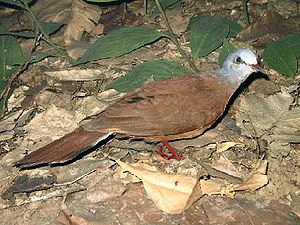Maiden dove
| Maiden dove | ||||||||||
|---|---|---|---|---|---|---|---|---|---|---|

Maiden dove ( Turtur brehmeri ) |
||||||||||
| Systematics | ||||||||||
|
||||||||||
| Scientific name | ||||||||||
| Turtur brehmeri | ||||||||||
| ( Hartlaub , 1875) |
The maiden dove ( Turtur brehmeri ), also known as the blue-headed forest dove, is a species of pigeon birds. It is the largest species in the African bush pigeon genus . It occurs exclusively in tropical Africa.
Appearance
The maiden pigeon reaches a body length of 25 centimeters. It is smaller than a laughing pigeon, but its body is somewhat more compact and the head is larger than that of this species of pigeon. The long tail in relation to the body size is striking. There is no gender dimorphism.
The maiden dove is distinctive because of its specific plumage. The head and neck are bright blue-gray. The rest of the body plumage is a rich reddish brown. This plumage shines reddish purple on the neck, on the mantle and the wing covers. The wings of the hand are dark. The beak is reddish gray at the base and becomes dull greenish towards the tip. The iris is black-brown. The feet are reddish.
distribution and habitat
The maiden dove colonizes only a relatively small area in Africa. It occurs from Sierra Leone and Liberia to the south of the Ivory Coast and Ghana. The range also includes southern Nigeria to southern Cameroon, Gabon and northern Congo to central Congo and Angola. It is a relatively rare species in the entire range. However, there can be a higher population density locally if sufficient food resources are available. The species almost exclusively inhabits primary rainforests.
Way of life
The maiden dove searches for food on the ground and nests in the undergrowth or low in trees. She avoids forest clearings. The food spectrum includes seeds and fruits lying on the ground. It also eats snails as well as insects and their larvae. The breeding time varies depending on the area of distribution. In Cameroon, the peak of the breeding season falls in August. In Gabon, however, the species breeds between December and May. The nest is a loose platform made of twigs and small roots. Unusually for pigeons, it is built on dry leaves. The nests are usually found at a height between 2.5 and 5.5 meters above the ground. The clutch consists of one or two eggs. The details of reproductive biology are known only through observations on cared for birds. There the young birds leave the nest after 14 days.
Keeping in human care
The maiden pigeon was first kept in Europe from 1870 by the London Zoo. The first breeding succeeded only in the 1950s. It is a very rare species in wild pigeon keeping. Imported animals are not only very shy at the beginning, but also often in poor physical condition. Breeding successes with this species are very rare.
supporting documents
Individual evidence
literature
- David Gibbs, Eustace Barnes and John Cox: Pigeons and Doves - A Guide to the Pigeons and Doves of the World . Pica Press, Sussex 2001, ISBN 90-74345-26-3 .
- Alois Münst and Josef Wolters: Tauben - The species of wild pigeons , 2nd expanded and revised edition, Verlag Karin Wolters, Bottrop 1999, ISBN 3-9801504-9-6 .
- Gerhard Rösler: The wild pigeons of the earth - free living, keeping and breeding . M. & H. Schaper Verlag, Alfeld-Hannover 1996, ISBN 3-7944-0184-0 .
Web link
- Turtur brehmeri inthe IUCN 2013 Red List of Threatened Species . Listed by: BirdLife International, 2012. Retrieved January 4, 2014.